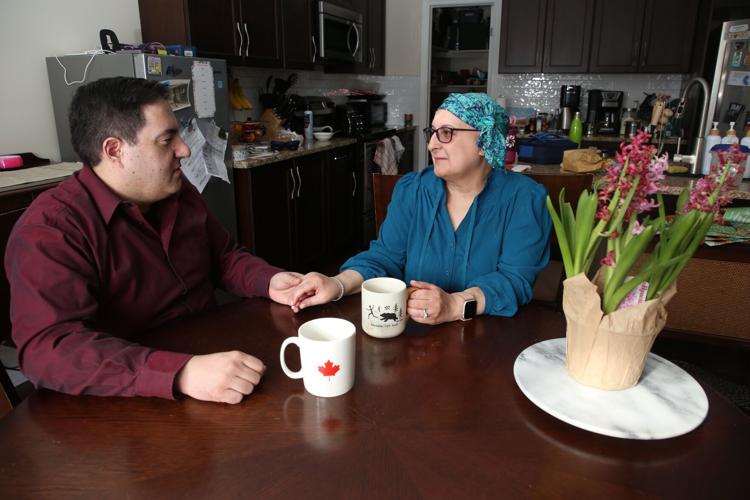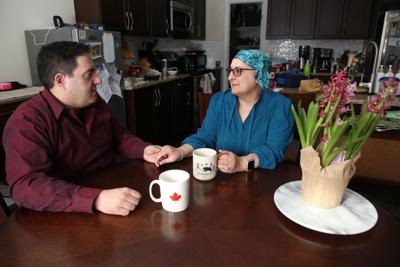Christina Shehata was told she had a life-threatening condition soon after she arrived at Kingston General Hospital’s emergency department.
The 51-year-old with metastatic breast cancer had a high fever, and tests revealed she lacked a type of white blood cell that fights infection, putting her at further risk.
Diagnosed with febrile neutropenia, a medical emergency for cancer patients, Christina quickly received IV antibiotics and was told she needed to be admitted.
But no in-patient beds were available. Instead, Christina remained in the emergency department. It would take 40 hours for her to get moved to an inpatient bed.
‚ÄúI was terrified for her,‚ÄĚ said her husband, Dr. Adam Shehata, a family physician.
He said Christina received appropriate care in the ED but waiting near other patients put her at high risk for an infection.
‚ÄúThe area she was in was essentially a row of hospital gurneys separated only by curtains with sick patients on either side of her,‚ÄĚ Adam said. ‚ÄúHer risk of infection was so high and there was nothing I could do to protect her.‚ÄĚ
According to an internal provincial report, patients visiting ERs in the past three years waited longer than they did in the previous 13 years. 
According to an internal provincial report, patients visiting ERs in the past three years waited longer than they did in the previous 13 years. 
Across Ontario, patients are waiting hours¬†‚ÄĒ sometimes days¬†‚ÄĒ in EDs, a problem that has gotten substantially worse over the last three years, according to provincial data obtained by the Star.
In many hospitals, patients waiting in the ED are being treated in hallways, storage areas and other unconventional spaces due to a lack of beds elsewhere in the hospital. This kind of ‚Äúhallway medicine‚ÄĚ frustrates patients but also risks their health and puts further stress on hospital staff struggling to cope in crowded conditions.
Health-care issues, including the family doctor shortage and hallway medicine, have emerged as key issues in the Feb. 27 snap election. During his 2018 campaign, Doug Ford promised to end hallway health care, making the pledge a key part of the Progressive Conservative platform.
Four months after getting elected, Ford stated, and said it was ‚Äúunacceptable‚ÄĚ for patients to wait hours to see a doctor or to get care in hospital hallways.
‚ÄúSince then, it‚Äôs gone from bad to worse,‚ÄĚ said Dr. Raghu Venugopal, an emergency physician in Toronto. ‚ÄúWhat bad hallway medicine was has only deteriorated to chair- and waiting-room medicine.‚ÄĚ
Venugopal cites a long list of conditions he had to treat in hospital chairs, including a brain bleed, a broken spine, a bowel obstruction and a heart attack.
Research shows patients who ‚Äúboard‚ÄĚ for hours in the ED, particularly older patients, .
‚ÄúIt isn‚Äôt just that patients get treated in hallways,‚ÄĚ said Dr. Andrew Petrosoniak, an emergency physician and trauma team leader at St. Michael‚Äôs Hospital. ‚ÄúPatients who require hospital-level care, their risk of death goes up the longer they‚Äôre in the emergency department. You can debate the percentages, but there is a not insignificant increase in mortality.‚ÄĚ
A report by Ontario Health, not previously made public, shows that between April 2022 and October 2024, wait times for patients needing an in-patient bed at the 90th percentile ranged from roughly 32 hours to just over 40 hours. This means 90 per cent of patients stayed in the ED for these lengths of time or less but 10 per cent stayed longer. Pre-pandemic, wait times for an in-patient bed at the 90th percentile ranged roughly from 20 to 30 hours.
Experts say a combination of factors are leading to extended ED waits: an insufficient number of hospital beds to admit new patients; a lack of long-term-care and home-care options, meaning patients who no longer need acute care have to remain in hospital; people relying on EDs due to a shortage of family doctors and difficulties getting diagnostic imaging and specialist care; and ongoing staffing shortages that limit how many patients hospitals can treat quickly.

Christina Shehata was only separated from other sick patients by curtains during her hours-long ER wait.
Ian G MacAlpine for the ļ£Ĺ«…Á«ÝĻŔÕÝStarIn recent years, hospitals have seen a rise in the number of very sick patients coming to the ED. These more complex patients, many with a combination of chronic illnesses, require more time to stabilize, assess and treat, which leads to longer wait times for other patients.
‚ÄúWe‚Äôre seeing more and more frail elderly, and the complexity of the cases that we‚Äôre seeing is that much greater,‚ÄĚ said Ottawa-based emergency physician Dr. James Worrall, who noted that Ontario‚Äôs population of people over 65 has increased dramatically in the past 20 years.
Since 2018, the Ford government has added 3,500 new hospital beds and has said 3,000 more are in the pipeline, tied to 50 new hospital projects. The province has said it has also made significant investments in long-term care. Before the election, the PCs pledged a $1.4 billion investment to connect every Ontarian to primary care by 2029.
In a statement, the Ministry of Health noted the province‚Äôs ‚ÄúED landscape and patient demographic have evolved over the years in particular from the pandemic experience,‚ÄĚ an issue ‚Äúnot unique to Ontario.‚ÄĚ
Adam, who took Christina to Kingston General Hospital on Feb. 9, said he does not blame the hospital or its staff for her long wait. He said doctors and nurses provided excellent care and understood the couple‚Äôs worries, but said they couldn’t move her due to capacity issues.
During the overnight hours, it got so loud that hospital staff gave Christina earplugs. Earlier that evening, Adam said, nearby patients were ill and coughing and a patient next to Christina had to use a commode.
‚ÄúThe stench was everywhere,‚ÄĚ said Adam, who was told no isolation rooms were available. ‚ÄúEveryone can understand why they wouldn‚Äôt want their sick wife, who doesn‚Äôt have the ability to fight off infection, beside someone who is defecating on one side and coughing on the other.‚ÄĚ
After more than 24 hours, Adam said Christina was moved out of the area with curtained-off gurneys and into a room with a door that closed. Though still in the ED, Adam said the new space offered more privacy and protection.

‚ÄúWe‚Äôre seeing more and more frail elderly and the complexity of the cases that we‚Äôre seeing is that much greater,‚ÄĚ said Ottawa-based emergency physician Dr. James Worrall.
James Park for theļ£Ĺ«…Á«ÝĻŔÕÝStarIn a statement, Kingston Health Sciences Centre (KHSC) said it has experienced a ‚Äúsustained increase in patient volumes and continues to operate at high capacity‚ÄĚ like many hospitals in Canada. It said this is primarily due to ‚Äúpopulation growth, as well as a growing number of patients with more complex needs than ever before.‚ÄĚ
KHSC said its teams are ‚Äúcommitted to providing timely, high-quality, safe care‚ÄĚ and that ‚Äúrooms and care space allocation‚ÄĚ is based on ‚Äúseveral factors, including patient acuity and specific medical needs.‚ÄĚ
Dr. Candace McNaughton, an emergency medicine physician at Sunnybrook hospital, said the challenges Ontario EDs face are more significant now than before COVID. She said individual hospitals and their staff are ‚Äúdoing everything they can with the limited resources they have,‚ÄĚ but it‚Äôs not enough.
‚ÄúMost of my health encounters start with, ‚ÄėI am so sorry for the wait,‚Äô ‚ÄĚ she said.
Recent research led by McNaughton showed that since 2020, more adults are leaving Ontario EDs without being seen by a physician. The study, , found these patients face a 14 per cent higher risk of death or hospitalization within seven days when compared to patients who left the ED without being seen by a physician before 2020.
McNaughton, a scientist at Sunnybrook Research Institute, said the study raises a ‚Äúconcerning signal‚ÄĚ that should prompt system-wide policy interventions.
‚ÄúThere‚Äôs something wrong with the system; people are not doing as well as they did pre-2020,‚ÄĚ she said.
After three days, Christina left the hospital following antibiotic treatment and she’s now well enough to resume cancer therapy. She said she hopes her experience will highlight longstanding system challenges and push politicians to act.
‚ÄúIt was ridiculous what I experienced,‚ÄĚ Christina said. ‚ÄúPeople lining the hallways. People behind these flimsy curtains. People not able to get seen by a doctor or get admitted right away.
‚ÄúIt shouldn‚Äôt be this way.‚ÄĚ


































To join the conversation set a first and last name in your user profile.
Sign in or register for free to join the Conversation